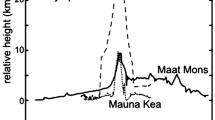Abstract
The opening of the Drake Passage and formation of the Scotia Plate started in the Early Oligocene (∼30 Ma). In spite of the intense studies of the last decades, the tectonic structure of the plate and its evolution remain a matter of debate. This work presents the ideas on the tectonic zoning of the Scotia Plate based on the complex analysis of the morphological peculiarities of the bottom relief, the anomalous gravity field in various reductions, and the anomalous magnetic field. The western, central, and eastern blocks of the plate distinct in the relief structure and geophysical fields are distinguished, and the possible evolution scenario of the plate is suggested.
Similar content being viewed by others
References
A. A. Bulychev, D. A. Gilod, A. N. Zaitsev, et al., “Structure of tectonosphere of the Scotia Sea based on analysis of gravimetric data,” Vestn. Mosk. Univ., Ser. 5: Geogr. 4, 69–80 (2002).
A. G. Gainanov and V. L. Panteleev, Marine Gravimetric Prospecting (Nedra, Moscow, 1991) [in Russian].
E. P. Dubinin, Transforming Breaks of Oceanic Lithosphere (Moscow State University, Moscow, 1987) [in Russian].
E. P. Dubinin, N. M. Sushchevskaya, and A. L. Grokhol’skii, “History of development of spreading ridges of Southern Atlantic and spatio-temporal position of Bouvet triple junction,” Ross. Zh. Nauk Zemle, No. 5, 423–443 (1999). http//eos.wdcb.rssi.ru/rjes/rjes-roohtm
G. B. Udintsev and G. V. Shenke, Description of Geodynamics of Western Antarctica (GEOS, Moscow, 2004) [in Russian].
G. B. Udintsev, G. V. Shenke, A. Beier, V. G. Udintsev, A. V. Kol’tsova, L. G. Domoratskaya, A. F. Beresnev, N. A. Kurentsova, and D. E. Teterin, “The Peary Plateau, fragment of Gondwana (barrier in the oceanic gates of the Western Antarctica in the Scotia Sea): a part of the Earth’s bipolar climatic machine,” Dokl. Earth Sci. 408 (4), 575–579 (2006).
G. B. Udintsev, A. F. Beresnev, N. A. Kurentsova, et al., “The Drake Passage and Scotia Sea are oceanic gates of the Western Antarctica,” in Input of Russia into International Polar Year 2007/08. Structure and History of Lithosphere Development, Ed by Yu. G. Leonov (Paulsen, St. Petersburg, 2010), pp. 64–88.
A. I. Shemenda and A. L. Grokhol’skii, “Geodynamics of South Antilles region,” Geotektonika, No. 1, 84–95 (1986).
P. Barker, I. Dalziel, and B. Storey, “Tectonic development of the Scotia arc region,” in The Geology of Antarctica (Clarendon Press, Oxford, 1991), pp. 215–248.
P. Barker, “Scotia Sea regional tectonic evolution: implications for mantle flow and palaeocirculation,” Earth-Sci. Rev. 55, 1–39 (2001).
G. Eagles, R. Livermore, and P. Morris, “Small basins in the Scotia Sea: The Eocene Drake Passage gateway,” Earth Planet. Sc. Lett. 206, 343–353 (2006).
G. Eagles, “The age and origin of the central Scotia Sea,” Geophys. J. Int. 183 (2), 587–600 (2010).
J. Galindo-Zaldivar, J. Balanya, F. Bohoyo, et al., “Active crystal fragmentation along the Scotia — Antarctic plate boundary east of the South Orkney Microcontinent (Antarctica),” Earth Planet Sci. Lett. 204, 33–46 (2002).
G. F. Jenks, “The data model concept in statistical mapping,” Int. Yearbook Cartogr. 7, 186–190 (1967).
R. Livermore, A. Cunningham, L. Vanneste, and R. Larter, “Subduction influence on magma supply at the East Scotia Ridge,” Earth Planet Sci. Lett. 150, 261–275 (1997).
A. Maldonado, A. Barnolas, F. Bohoyo, et al., “Contourite deposits in the central Scotia Sea: the importance of the Antarctic Circumpolar Current and the Weddell Gyre flows,” Palaeogeogr., Palaeoclimatol., Palaeoecol. 198, 187–221 (2003).
A. Maldonado, J. Balanyá, A. Barnolas, et al., “Tectonics of an extinct ridge-transform intersection, Drake Passage (Antarctica),” Mar. Geophys. Res. 21 (1), 43–68 (2000).
S. Maus, U. Barckhausen, H. Berkenbosch, et al., “EMAG2: A 2-arc min resolution Earth Magnetic Anomaly Grid compiled from satellite, airborne, and marine magnetic measurements,” Geochem. Geophys. Geosyst. 10 (8), 1–12 (2009).
A. M. Pelayo and D. A. Weins, “Seismotectonics and Relative Plate Motions in the Scotia Sea Region,” J. Geophys. Res., B 94 (6), 7293–7320 (1989).
D. T. Sandwell and W. H. F. Smith, “Marine gravity anomaly from Geosat and ERS_1 satellite altimetry,” J. Geophys. Res. 102, 10039–10054 (1997).
S. Susini and M. Donatis, “3D model of a sector of the South Scotia Ridge (Antarctica),” Comput. Geosci. 35, 83–91 (2009).
S. Uyeda and H. Kanamori, “Bark-arc opening and the mode of subduction,” J. Geophys. Res., B 84 (3), 1049–1061 (1979).
Author information
Authors and Affiliations
Corresponding author
Rights and permissions
About this article
Cite this article
Teterin, D.E., Dubinin, E.P., Udintsev, G.B. et al. Major tectonic elements of the Scotia Plate. Oceanology 55, 236–244 (2015). https://doi.org/10.1134/S0001437015020174
Received:
Accepted:
Published:
Issue Date:
DOI: https://doi.org/10.1134/S0001437015020174




